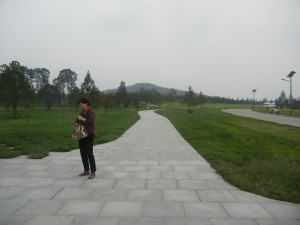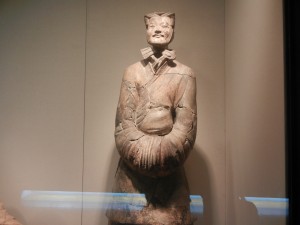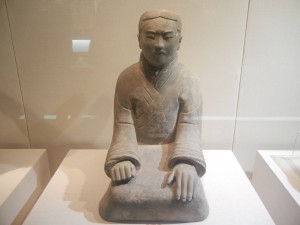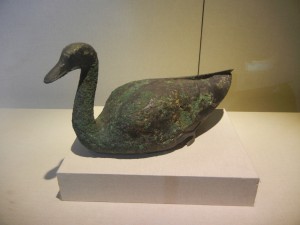Believe it or not, what you see below is only a small part of the terra-cotta army’s world.
Qin Shihuang planned to take much more into the afterlife, and the 7000+ soldiers, archers, calvary-men and officers that he commissioned aren’t even in the major part of his tomb. Let’s find out what they’re guarding.
The central part of Qin Shihuang’s burial complex was a funerary park (ling yuan) that two rectangular walls enclosed. The outer measured 2,165 meters north to south and 940 meters east to west. A pyramid-shaped mound is in the southern half.
It’s about 165 feet high now, and it was probably higher back in the day. The terra-cotta warriors are east of the mound (near where I took the above picture from). Qin Shihuang’s tomb is under the mountain, and it has yet to be opened. But Sima Qian, who wrote a monumental history of the known world under the Han emperor Wudi (r. 141-87 BCE), gave a dazzling description.
Qin Shihuang began building the mound as soon as he took the Qin throne in 246 BCE. When he unified China in 221 BCE, he transported 700,000 men from all over the empire to work on his tomb. They fashioned replicas of palaces, observation towers, and daily utensils. They used mercury to make imitations of the 100 rivers, the Yellow River, the Yangtze and the ocean. They also represented all the known heavenly bodies. They used “man-fish” oil for lamps, which would burn for a long time without extinguishing. All Janis Joplin asked the Lord for was a Mercedes Benz, but Qin Shihuang wanted nothing less than the whole universe.
A large complex of buildings stood to the north of the mound, and they have been identified as sacrificial halls in which people placed ritual offerings to the king’s spirit. A walled area in the northeast corner of the central enclosure has rows of tombs. Wu Hung, in Chinese Sculpture (in the Yale series on Chinese art) thinks they were probably son-less consorts who were forced to accompany Qin Shihuang in the afterlife.
The man in the above shot is a civil official, with an expression that’s both proud and gentle–an ideal person for running the governmental machinery. He and several similar figures were found in a burial pit to the immediate southwest of the tomb mound.
Stable pits were found to the east and west of the mound, and the attendant in the above photo awaiting orders is from one of them. Another pit contained acrobats.
Another pit had figures of animals and birds, including the goose in the above shot. This underground zoo was managed by ceramic zookeepers.
There’s the saying, You can’t take it with you, but Qin Shihuang tried to take the whole universe with him. Egyptian pharaohs built pyramids which they thought would transform their bodies into a more spiritual existence, but none devoted so many resources to replicating the whole world around the pyramid.
Qin Shihuang is a complex figure in Chinese history. He’s been detested for his cruelty and admired for being the first king to organize all of China into a state. We’ll discover that he built much more than his tomb in the next post on the world of the terra-cotta army.
But if I pass away before I write the next post, I’ll be happy with my library, musical instruments and CD collection.






{ 1 comment }
Great information. Lucky me I ran across your site by accident
(stumbleupon). I’ve bookmarked it for later!
Comments on this entry are closed.